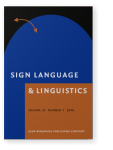Vol. 21:1 (2018) ► pp.77–114
Wh-clefts as evidence of resultatives in ASL
The status of syntactic resultative constructions has been disputed in the American Sign Language (ASL) literature. These are single sentences such as “Mary hammered the metal flat,” where two predicates share the same object and an event (hammered) causes the affected object (the metal) to change state (flat) as a result. While not all languages permit such constructions, this study shows that (several) alternate multi-sentential analyses can be ruled out. WH-clefts are used to provide a test for independent clausal boundaries, providing additional support that American Sign Language (ASL) permits resultative constructions. We also observe possible word order variations and note common features of the result predicates in these constructions.
Article outline
- 1.Resultatives: A window into complex structure
- 1.1Previous research on ASL resultatives: Differing claims
- 1.2Organization of paper
- 2.Establishing resultatives in ASL
- 2.1Resultative constructions as single clauses
- 2.2The current dilemma: Sentential boundaries
- 2.3WH-clefts as test for clausal boundaries
- 2.4WH-cleft constituency test eliminates two-independent-clause analysis
- 2.5Internal syntax
- 2.6Further discussion
- 3.Presentation of word order variation and discussion of constraints governing it
- 4.Analyzing items through the Event Visibility Hypothesis
- 4.1Overview of the Event Visibility Hypothesis
- 4.2Transparent encoding of change-of-state in result predicates
- 4.3Additional description and discussion of classifiers
- 4.4Discussion on encoding change of state
- 5.Conclusion
- Acknowledgements
- Notes
-
References
